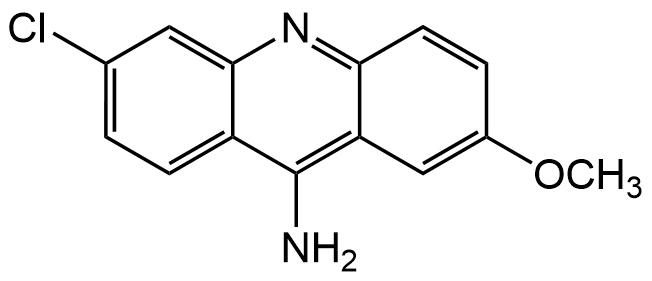9-Amino-6-chloro-2-methoxyacridine
Product Code:
CDX-A0099
CDX-A0099
Regulatory Status:
RUO
RUO
Shipping:
Ambient
Ambient
Storage:
Short term: +4°C. Long term: -20°C
Short term: +4°C. Long term: -20°C
No additional charges, what you see is what you pay! *
| Code | Size | Price |
|---|
| CDX-A0099-M025 | 25 mg | £243.00 |
Quantity:
| CDX-A0099-M050 | 50 mg | £417.00 |
Quantity:
Prices exclude any Taxes / VAT
Stay in control of your spending. These prices have no additional charges to UK mainland customers, not even shipping!
* Rare exceptions are clearly labelled (only 0.14% of items!).
* Rare exceptions are clearly labelled (only 0.14% of items!).
Multibuy discounts available! Contact us to find what you can save.
This product comes from: Switzerland.
Typical lead time: 7-10 working days.
Contact us for more accurate information.
Typical lead time: 7-10 working days.
Contact us for more accurate information.
- Further Information
- Documents
- References
- Show All
Further Information
Appearance:
Yellow to orange powder.
CAS:
02.09.3548
Description:
9-Amino-6-chloro-2-methoxyacridine (ACMA) is a cell-permeable ph-sensitive fluorescent probe that intercalates into DNA. It selectively binds to poly(dA-dT) sequences with the fluorescence lifetime decreasing with incorporation of guanosine. It is used for nucleic acid staining/labeling. ACMA fluorescence is pH-dependent and is quenched when a pH gradient is established. Spectral Data: lambdaex 411nm; lambdaem 475nm (in methanol). Excitation of the ACMA-DNA complex (excitation/emission maxima lambda419/483 nm) is possible with most UV-light sources, making it compatible for use with both shorter- and longer-wavelength dyes. ACMA also apparently binds to membranes in the energized state and becomes quenched if a pH gradient forms. It has been extensively employed to follow cation and anion movement across membranes and to study the proton-pumping activity of various membrane-bound ATPases. ACMA also inhibits acetylcholinesterase.
EClass:
32160000
Form:
solid
GHS:
GHS07
Handling Advice:
Protect from light and moisture.
Hazards:
H302-H315-H319-H335
InChi:
InChI=1S/C14H11ClN2O/c1-18-9-3-5-12-11(7-9)14(16)10-4-2-8(15)6-13(10)17-12/h2-7H,1H3,(H2,16,17)
InChi Key:
IHHSSHCBRVYGJX-UHFFFAOYSA-N
MDL:
MFCD07374304
Molecular Formula:
C14H11ClN2O
Molecular Weight:
258.7
Package Type:
Vial
Precautions:
P501-P270-P264-P280-P302+P352-P337+P313-P305+P351+P338-P362+P364-P332+P313-P301+P312+P330
Purity:
>95% (HPLC)
Signal word:
Warning
SMILES:
ClC1=CC=C(C(N)=C(C=C(OC)C=C2)C2=N3)C3=C1
Solubility:
Soluble in DMSO, DMF or methanol (1mg/ml).
Source / Host:
Synthetic
Transportation:
Non-hazardous
UNSPSC Number:
41105331
Use & Stability:
Stable for at least 2 years after receipt when stored at -20°C.
Documents
References
(1) C. Helene, et al.; Biochem. Soc. Trans. 14, 201 (1986) | (2) T. Hard, et al.; J. Phys. Chem. 93, 4338 (1989) | (3) H. Rottenberg & R. Moreno-Sanchez; Biochim. Biophys. Acta 1183, 161 (1993) | (4) S.D. Watts & R.A. Capaldi; J. Biol. Chem. 272, 15065 (1997) | (5) K. Fukui, et al.; J. Photochem. Photobiol. B Biol. 50, 18 (1999) | (6) S. Bencharit, et al.; Chem. Biol. 10, 341 (2003) | (7) I. Carqueijeiro, et al.; Methods Mol. Biol. 1405, 121 (2016) | (8) P. Uzdavinys, et al.; PNAS 114, E1101 (2017)



